B-17engineer
Colonel
Hi guys,
My dad said a friend at work gave him the Revell 1/48 B-25 kit for some reason. So I'm toying with the Idea of making it an RAF bird.
Question(s) are:
What units in the RAF had a B-25?
Where can I find decals?
My dad said a friend at work gave him the Revell 1/48 B-25 kit for some reason. So I'm toying with the Idea of making it an RAF bird.
Question(s) are:
What units in the RAF had a B-25?
Where can I find decals?





